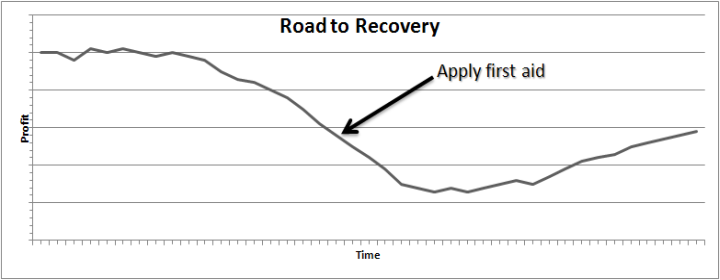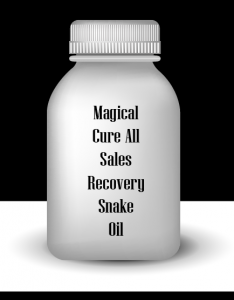
Many of us have been there and some of us are yet to experience the gut wrenching experience when we finally, consciously realise that our sales pipeline and revenue numbers are in drastic decline and we are in deep, deep trouble. We realise all too dramatically that we are having the business and sales equivalent of a heart attack.
The brutal facts finally hit us hard in our face, our chest, our guts and we realise we may not survive.
Yet, the causes and signs were there for us all to see. Like a heart attack, a combination of activities caused this to happen over a long period of time and deep down many of us knew that things weren’t going quite right.
So why do let this happen to us? And how do we recover from a ‘fatal’ sales heart attack?
First, let’s take a look at why we don’t see some of danger signs before it’s (often) too late.
We usually focus on and notice the results (outputs) of our sales performance first. For instance, monthly revenue figures are in decline. One month here or there, maybe that is a momentary blip; but several months in a row, then that is becoming a systemic problem especially when we find out the cause of our revenue decline was due to a drop off in our new business development (input) activities. This is a real issue particularly if our sales cycle is 2 months or longer because by the time we notice the decline in revenue we are already 2+ months behind. The amount of effort required to get things back on track and in sync is monumental and unless everyone in our business gets involved with the sales effort and prospects for new business we may not be around much longer. (Think lack of regular exercise.)
 We also notice some ‘chest pains’ when we get less business coming in from once reliable business categories or channels but we often dismiss these ‘pains’ as indigestion, something temporary, and keep on going down the same path. Often failing to listen to customers and salespeople inputs, or not taking heed of how our markets are changing, can leave us unable to adapt fast enough to changing demands of customers and markets. (Think lack of variety in one’s diet)
We also notice some ‘chest pains’ when we get less business coming in from once reliable business categories or channels but we often dismiss these ‘pains’ as indigestion, something temporary, and keep on going down the same path. Often failing to listen to customers and salespeople inputs, or not taking heed of how our markets are changing, can leave us unable to adapt fast enough to changing demands of customers and markets. (Think lack of variety in one’s diet)
Sometimes we can get distracted by so called ‘gurus’ or influential team member(s) promising us magical cure-alls that end up distracting us from our real game. Many people become distracted by fads and silver bullet point solutions, always looking for the easy way out to make or save money. All the effort, time and money that goes into ‘implementing’ these fads would have been better invested in real sales strategy and operational effectiveness, giving sales teams a clear sales mission and mandate to go to market and develop healthy, sustainable and profitable client relationships built for the long term. (Think fad diets and junk food)
This sales ‘heart attack’ can happen to all types of organisations, large and small alike but the consequences become more evident, faster within smaller organisations which can lead to devastating outcomes. Larger organisations, in general, seem to be better able to survive these challenging conditions because they often have inertia in their market segments which can offer some protective qualities, but only for so long. If they do not address their sales issues they too will succumb to a sales ‘heart attack’. Think Kodak, Lehman Brothers, Arthur Anderson, Blockbuster, and Borders for instance.
So how do we survive this trauma and apply sales first aid to achieve a sales recovery?
We need to apply the Sales CPR
Many of us know CPR is a medical term that stands for Cardiopulmonary Resuscitation which is a combination of techniques, including chest compressions, designed to pump the heart to get blood circulating and deliver oxygen to the brain until definitive treatment can stimulate the heart to start working again.
So what’s the Sales CPR?
Checklist. We need to check that our Sales Strategy and Go-to-market action Plan are pointing us in the right direction and everything is aligned.
We need to check that our sales strategy can clearly define our value and real points of difference in our market place. Accompanying this we need to have properly defined the right (micro) market segments we need to be selling into with the right value propositions and resources for maximum sales effect. We also need to check that our sales efforts and teams are guided by a clear purpose, tangible goals and tactics, clear performance standards and values, all rolled up into an effective Sales Mission.
Prospect for new business opportunities in new and existing accounts on a consistent daily basis.
Prospecting is the oxygen that fuels our sales businesses and keeps us sales fit. So we need to make sure that we do not leave prospecting and new business development to chance, instead we need to be prospecting every day into those market segments that are right for our business. Like exercise, we need to prospect every day. We also need to immediately seek to overcome any sales call reluctance issues plaguing our psyche because salespeople who do not hesitate to prospect are 5 times more productive than their call reluctant sales colleagues.
Relationships built on real value are crucial to ongoing business and sales success.
True, good relationships take time to build so from the start we must ensure that we are well trained to understand what our prospects and clients are looking to achieve and clearly demonstrate how we can help them be successful. No more ‘showing up and throwing up information’ as a default selling position. Solution Selling (read insight selling, challenger selling, empathy selling, diagnostic selling, etc.) is the vital sales capability we need to embed into every sales team now. Our client will be forever grateful if we make the transition.
However, the best cure is – Prevention!
The lesson: let’s not get ourselves in this pickle in the first place by setting up ourselves up for success from the get go and never take our eye of the ball.
Remember everybody lives by selling something.
Author: Sue Barrett, www.barrett.com.au
Sue Barrett is the founder and CEO of the innovative and forward thinking sales advisory and education firm, Barrett and the online sales education & resource platform www.salesessentials.com. Sue was the first in Australia to get Selling a university qualification and has written more than 600 blog posts and 21 e-books on sales and with her team produces the ‘must read’ Annual 12 Sales Trends Report. Striving for better sales practices and improving sales teams and operations, Sue is a Sales Philosopher, Activist, Strategist, Speaker, Trainer and Adviser. Get to know her further on Twitter, Facebook, and Youtube.
If you valued this article, please hit the ‘like’ button and also share via your Twitter, LinkedIn, Google+ and Facebook social media platforms. You are welcome to join the conversation or ask questions so feel free to add a comment on this post.



New Article Email Notification